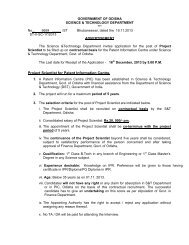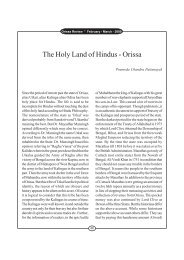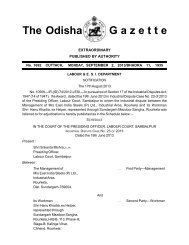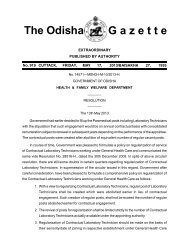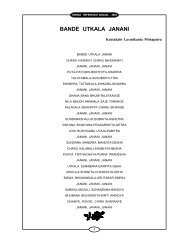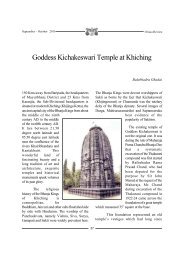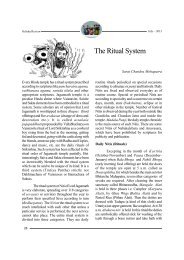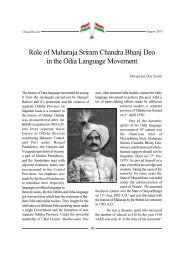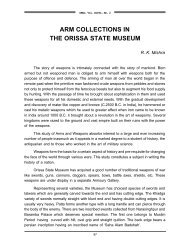“Imagery of Sarala Dasa” - Odisha.gov.in
“Imagery of Sarala Dasa” - Odisha.gov.in
“Imagery of Sarala Dasa” - Odisha.gov.in
Create successful ePaper yourself
Turn your PDF publications into a flip-book with our unique Google optimized e-Paper software.
December - 2012<br />
<strong>Odisha</strong> Review<br />
<strong>“Imagery</strong> <strong>of</strong> <strong>Sarala</strong> <strong>Dasa”</strong><br />
Dr. Santosh Tripathy<br />
I<br />
Before enter<strong>in</strong>g <strong>in</strong>to the actual subject matter <strong>of</strong><br />
our discussion it is wise to add a few <strong>in</strong>troductory<br />
l<strong>in</strong>es on eternal poetry, poetic picture and <strong>Sarala</strong>’s<br />
concept <strong>of</strong> poetry.<br />
Firstly eternal poetry always illum<strong>in</strong>ates<br />
magnanimous perceptions towards life-time-race<br />
and truth. The suggestion by the imag<strong>in</strong>ation, <strong>of</strong><br />
noble grounds for the noble emotions is the<br />
essential quality <strong>of</strong> excellent poetry. The content<br />
<strong>of</strong> true poetry is imag<strong>in</strong>ative and emotional<br />
<strong>in</strong>terpretation <strong>of</strong> life-relevant. This creative<br />
<strong>in</strong>terpretation <strong>of</strong> truth must be clothed <strong>in</strong> a<br />
systematically rhythmical language and figurative<br />
diction. Figures <strong>of</strong> speech and metrical diction are<br />
essential to the emotional and evocative appeal<br />
<strong>of</strong> poetry. This type <strong>of</strong> pictorial significance <strong>of</strong><br />
expression is known as imagery <strong>of</strong> poetry.<br />
It is needless to say that the image is an<br />
impression <strong>of</strong> the object <strong>in</strong> the m<strong>in</strong>d <strong>of</strong> viewer. It<br />
is a poetic device, which consists <strong>in</strong> the use <strong>of</strong><br />
pictorial words and phrases <strong>in</strong> such an objective<br />
manner as to make the mean<strong>in</strong>g more po<strong>in</strong>ted,<br />
clear, impressive, absolute, emphastic and the<br />
language more graphic and vivid. Imagery is an<br />
illustrative process <strong>of</strong> poetry by which poetic idea<br />
ascends from external world to <strong>in</strong>ternal world.<br />
Simply Imagery turns every th<strong>in</strong>g to lovel<strong>in</strong>ess and<br />
gives tenderness and propriety to a poetic vision.<br />
Now, we can arbitrate the <strong>Sarala</strong>’s<br />
concept <strong>of</strong> poetry. The western analysts <strong>of</strong><br />
Imagery trends, even our Ritiyangika stalwarts<br />
believe that the two types <strong>of</strong> poet can play pictorial<br />
game <strong>in</strong> the poetry-field. The first category is<br />
products <strong>of</strong> an age. Such poet may aggreable as<br />
secand grade poet or Sebita Kabi. The creative<br />
fancy <strong>of</strong> the second grade poet is to pursuit the<br />
trends and factors <strong>of</strong> age. But the second category<br />
poet is acceptable as creator <strong>of</strong> an age. He is<br />
honoured first grade poet and well known as<br />
Ch<strong>in</strong>ta-mani Kabi. His easemplastic power can<br />
change the traditional discourse and establish new<br />
justice with <strong>in</strong>novative shape <strong>in</strong> flow <strong>of</strong> literature.<br />
Our national-epic-creator <strong>Sarala</strong><br />
Chandi Dasa has been accepted as Ch<strong>in</strong>tamani<br />
kabi <strong>in</strong> the brilliant galaxy <strong>of</strong> the Pan-Indian<br />
poets. He is a prom<strong>in</strong>ent figure and our<br />
Sahrudayas consider him as a best talent and Adiresource<br />
<strong>of</strong> the post-Sanskrit-Indian literary<br />
history. His poetic Imag<strong>in</strong>ation has <strong>in</strong>ter-tw<strong>in</strong>ed<br />
pastoral figures <strong>of</strong> speech and poetic diction with<br />
new-judgment and challenged the traditional<br />
classical Byasaic vision and discourse.<br />
In <strong>Sarala</strong>’s imag<strong>in</strong>ation there is no room<br />
for the elitist Sanskrit literature consider<strong>in</strong>g the<br />
contemporary history and socio-cultural reality.<br />
So, his imagery, style and diction were highly<br />
conditioned by vernacular rather than by classical<br />
41
<strong>Odisha</strong> Review December - 2012<br />
language and stylization. He preferred the familiar,<br />
colloquial and day to day content words to the<br />
unfamiliar one. Later on his contemporary<br />
mythological poets as well as the poets <strong>of</strong> the<br />
follow<strong>in</strong>g generations <strong>of</strong> the eastern India were<br />
greatly <strong>in</strong>spired by his poetic diction and<br />
phraseology as far as the imagery is concerned.<br />
In response to historical viewpo<strong>in</strong>t <strong>Sarala</strong><br />
Dasa, a poet <strong>of</strong> the fifteen century (contemporary<br />
<strong>of</strong> Suryavamsi k<strong>in</strong>g Kapilendra Dev, the great) is<br />
universally regarded as the ‘Adi Kabi’ or<br />
orig<strong>in</strong>ator <strong>of</strong> the Odia literature. His immortal<br />
works (Mahabharat, Bilanka Ramayana, Chandi<br />
Purana, etc) are remarkable for development <strong>of</strong><br />
common social sentiments, cultural rituals, socio<br />
ethical life style del<strong>in</strong>eation <strong>of</strong> earthly character,<br />
synthesis <strong>of</strong> Dravidian – Aryan – Austric cultures<br />
and religious picturesque descriptions and<br />
excellent use <strong>of</strong> various poetic figures and metre<br />
<strong>of</strong> folk style. One peculiarity <strong>of</strong> his magnum<br />
Mahabharata and Chandi Purana is that both l<strong>in</strong>er<br />
<strong>of</strong> a verse do not comprise an equal number <strong>of</strong><br />
letters, but the last rhythmic letters <strong>of</strong> the l<strong>in</strong>es<br />
produce and multiply the monotonous sound. By<br />
the fifteenth century the Odia language and its<br />
poetic quality had asserted almost its new<br />
powerful novel form and had become ripe for<br />
poetic constructions. The compos<strong>in</strong>g cultivator<br />
Sarola utilized this language as a literary existence.<br />
Poetic creativeness was <strong>in</strong> the blood <strong>of</strong><br />
<strong>Sarala</strong> Dasa and it flowed from his shackle stylus<br />
as words flowed from his soily experienced<br />
mouth. His epical-verses are lucid, untraceable,<br />
simple, folky, captivat<strong>in</strong>g, credible, forceful,<br />
musical and able to beget a psychic image <strong>in</strong> the<br />
reader’s m<strong>in</strong>d. His solo-ornatic poetic style and<br />
diction is generally stated <strong>in</strong> common base and<br />
place. The creativeness <strong>of</strong> sarala was no chooser<br />
<strong>of</strong> words as bad or goods. All type <strong>of</strong> words be<strong>in</strong>g<br />
equally worthful for him to create a new mythic<br />
image and poetical illustration. The predom<strong>in</strong>ant<br />
sentiment <strong>in</strong> <strong>Sarala</strong>’s poetic power is to orig<strong>in</strong>ate<br />
new images, the imageries are <strong>of</strong> love, devotion,<br />
ritual, idiomatic faith, war and common life.<br />
<strong>Sarala</strong>’s imag<strong>in</strong>ary creations formed a<br />
perpetual source <strong>of</strong> <strong>in</strong>spiration to the succeed<strong>in</strong>g<br />
generations <strong>of</strong> Odia and its neighbour language<br />
writers. It is true to speak that till the perennial<br />
stream <strong>of</strong> <strong>Sarala</strong>’s imagery-talent has no break.<br />
The image pattern and formation technique <strong>of</strong><br />
imagery <strong>of</strong> <strong>Sarala</strong> Dasa is based on two dist<strong>in</strong>ctive<br />
manner. One is words appearance as a group to<br />
suggest the theme as a picture and other one is<br />
episodic elucidative image. In this manner an<br />
<strong>in</strong>cidental narrative episode also able to act as an<br />
elucidative picture by story play<strong>in</strong>g imag<strong>in</strong>ation<br />
<strong>of</strong> poet. The scope <strong>of</strong> our subject <strong>“Imagery</strong> <strong>of</strong><br />
<strong>Sarala</strong> <strong>Dasa”</strong> is vast. The subject is be<strong>in</strong>g only<br />
a study <strong>of</strong> the salient features <strong>of</strong> the imagecomponent<br />
<strong>in</strong> the <strong>Sarala</strong>’s Mahabharat.<br />
Though our Adikabi was hardly vigilant<br />
<strong>of</strong> experimental imagism or even the great<br />
rhetorical tradition <strong>of</strong> the middle age, or the<br />
romantic images <strong>of</strong> modern trends, still his poetry<br />
is a perfect replica <strong>of</strong> all the said qualities. His<br />
“Adoshou Sagunou - Bibhabana Kabi<br />
Byapara” glorified and dignified the Odia<br />
language and literature and founded a new<br />
figurative style <strong>in</strong> the genre. His thought –<br />
provok<strong>in</strong>g, transformative sensuous images are<br />
chosen and orig<strong>in</strong>ated from visual realities and are<br />
ultimately perceived by his readers as<br />
psychological realities. Clarify<strong>in</strong>g own poetic<br />
concept as an “AJONI-KABYA-PRATIVA or<br />
TULYA-DEHI TULYA-PRATIVA”, <strong>Sarala</strong><br />
claims strongly that- “Adrustiki drusti muh<strong>in</strong><br />
karaeli ani”, it means his imagery creative m<strong>in</strong>d<br />
has been able to make <strong>in</strong>visible visible and the<br />
abstract concreteness.<br />
42
December - 2012<br />
Before <strong>Sarala</strong> Dasa <strong>in</strong> the Sanskrit<br />
Puranas and court epics, narratives were told <strong>in</strong><br />
transcendental diction, but <strong>Sarala</strong> has broken this<br />
punditocratic process and entered <strong>in</strong>to a discourse<br />
<strong>of</strong> <strong>in</strong>terpretations’. He has rejected the lexical and<br />
classical-rigorous styles and highlighted a new<br />
design <strong>of</strong> spontaneous figurative <strong>in</strong>terpretation. His<br />
aesthetic creativeness and imagery expression<br />
was based on six factors. These are-<br />
1. Pictorial quality <strong>of</strong> the words.<br />
2. Discover<strong>in</strong>g the higher truth, even<br />
Absolute <strong>in</strong> the material world through an abstract<br />
vision.<br />
3. Blend<strong>in</strong>g <strong>of</strong> behavioural words with the<br />
standard dictions.<br />
4. Composed on ironic, dramatic,<br />
onomatopoeic presentation and approaches.<br />
5. Unique-expression <strong>of</strong> ornamental images<br />
with an objectified-process.<br />
6. Synthesis <strong>of</strong> elegance, suggestiveness,<br />
comparison and similarity.<br />
Part - II<br />
Ellipsis, metaphoric comparison,<br />
motivated act, conferr<strong>in</strong>g <strong>of</strong> mean<strong>in</strong>g, afferentperformance,<br />
empirical photography <strong>of</strong> object,<br />
de-personalization pr<strong>in</strong>ciples, de-text <strong>of</strong> facts and<br />
<strong>Odisha</strong> Review<br />
verbosity are the magical characteristics <strong>of</strong><br />
Sarola’s imagery, which have drawn <strong>in</strong> a universal<br />
<strong>in</strong> his ever-readable works – Mahabharat, Chandi<br />
Puran, Bilanka Ramayana and Malashrees.<br />
It is true that Sarola has no chance to<br />
acquire the applied knowledge about us<strong>in</strong>g <strong>of</strong><br />
Concrete/Broken/Coupl<strong>in</strong>g/Colored/Sensitive/<br />
Allegorical/Content oriented/ and liv<strong>in</strong>g images<br />
like us<strong>in</strong>g <strong>of</strong> simile, epic simile, metaphor,<br />
hyperbole, personification, pathetic fallacy,<br />
antithesis, equivocate, exaggeration fantasy,<br />
amplification fancy, dissimilitude contrast, paradox<br />
and metonymy. It is surprise, the ancient-Sarola<br />
has believed (like a modernist) that better poetry<br />
can compose and perceive through imag<strong>in</strong>ation<br />
and passion. His penetration has understood also,<br />
poetry relates to whatever gives immediate<br />
pleasure to the m<strong>in</strong>d and evocates the emotions<br />
<strong>of</strong> all time through the figurative and hyperbole<br />
(Atisyoki) manner. It was happened only for his<br />
“Prarabdha Basana”(Anti-<strong>in</strong>nate purified<br />
tendency) and <strong>in</strong>born talent. The pre-time images<br />
such as simile, metaphor, metaphor, atisayokti,<br />
utpreksha, brakroti, ullekha and other similar<br />
aesthetic projections play prom<strong>in</strong>ent role for<br />
transferr<strong>in</strong>g the artistic experience <strong>of</strong> poets m<strong>in</strong>d<br />
to the heart <strong>of</strong> a ref<strong>in</strong>ed reader. The boldness <strong>of</strong><br />
his imagery method is objectified and personified.<br />
Here are some illustrated examples:-<br />
Odia verse <strong>of</strong> <strong>Sarala</strong> Translated mean<strong>in</strong>g Imagery speciality<br />
* Sutra chh<strong>in</strong>da kendra ki * What tune a kendra ( a * It is a recreative image. Here,<br />
aba sura viaeba/Amla dia s<strong>in</strong>gle str<strong>in</strong>ged musical poetical fancy is well-laid and alleg<br />
dugdha ki swadaku paeba." <strong>in</strong>strument as lyre used orized through a synthesis process<br />
by Nath-jogi or mendicants <strong>of</strong> Sanskrit, <strong>in</strong>digenous and Sanskrit<br />
<strong>of</strong> <strong>Odisha</strong>) will throw : if orig<strong>in</strong>ated words. Here, metaphor<br />
str<strong>in</strong>g is torned. How can and hyperbole are well-settled<br />
tamar<strong>in</strong>d (sour) mixed milk jo<strong>in</strong>tly and able to draw the mental<br />
will measure up to the taste picture <strong>of</strong> grief-m<strong>in</strong>ded Draupadi.<br />
<strong>of</strong> real milk.<br />
43
<strong>Odisha</strong> Review December - 2012<br />
* "Manaba heba yatharu badi * Just as a flower<strong>in</strong>g tree is * It is a specimen <strong>of</strong> <strong>Sarala</strong>'s liv<strong>in</strong>g -<br />
samsare kichhi nah<strong>in</strong>/phuta far better than barren one image and universal epic feel<strong>in</strong>g. Its<br />
nta bruksha tharu aphutanta /be<strong>in</strong>g a proper man much speciality is based on paradoxical<br />
brukshaki priti karahoe." <strong>in</strong> this same way/which is fancy. The productive imag<strong>in</strong>ation<br />
far greater than claim<strong>in</strong>g a <strong>of</strong> poet's m<strong>in</strong>d is able to give a<br />
man. figurative mean<strong>in</strong>g <strong>of</strong> complete and<br />
proper man through positive imageflower<strong>in</strong>g<br />
tree and negative image<br />
barren tree with a paradoxical<br />
manner. On the other hand <strong>in</strong>tellectual<br />
image- "barren and flower<strong>in</strong>g<br />
tree" and emotional image - "be<strong>in</strong>g<br />
a proper man", both are laid to<br />
give a vitality to figurative mean<strong>in</strong>g.<br />
Here, a ref<strong>in</strong>ed reader can corelate<br />
himself with the Ezra pound's<br />
def<strong>in</strong>ition - An image is that which<br />
presents an <strong>in</strong>tellectual and emotional<br />
complex <strong>in</strong> an <strong>in</strong>stant time.<br />
* "Apurana asaye Parama * It is a common belief that * It is a mental allegorical-picture <strong>of</strong><br />
dukkha samaste bichari." unfulfilled desires are cause Kunti as well as poet Sarola.<br />
<strong>of</strong> supreme distress. Through this psychic-figurative<br />
speech Sarola would like to <strong>in</strong>form<br />
his readers that the unfulfilled<br />
desires <strong>of</strong> Pandavas/ Kauravas /<br />
Karna/Arjuna/ and ma<strong>in</strong>ly<br />
Draupadi are root cause <strong>of</strong><br />
extreme - distress, that is<br />
Mahabharata - Mahasamar. It was<br />
well-known to Kunti as an image<br />
<strong>of</strong> archetypical mother.<br />
Personification is really a special k<strong>in</strong>d <strong>of</strong> metaphor<br />
for Sudramuni <strong>in</strong> which <strong>in</strong>animate objects and<br />
abstract ideas or other k<strong>in</strong>d <strong>of</strong> liv<strong>in</strong>gs spoken <strong>of</strong>,<br />
as if they are human be<strong>in</strong>gs. In this sense his whole<br />
poetic world is an illusory world <strong>in</strong> which<br />
abstractions become concreteness and endowed<br />
with life-colour and form. A flower, a tree, a river<br />
a forest, a bird, a dog, a snake, a mounta<strong>in</strong>, an<br />
emotion, a mood, an idea; whatever else all<br />
participate as a liv<strong>in</strong>g be<strong>in</strong>g <strong>in</strong> the life game <strong>of</strong> the<br />
characters. Human personality and its <strong>in</strong>ner beauty<br />
are depicted <strong>in</strong> terms <strong>of</strong> natural th<strong>in</strong>gs <strong>of</strong> beauty<br />
for example:-<br />
44
December - 2012<br />
• Vabilaki dware subidhaye khada khada kale<br />
(He/Sakuni thought that opportunity knocked<br />
at his door).<br />
• “Bikasita kusuma praye alap karuachhi<br />
(talk<strong>in</strong>g just like bloom<strong>in</strong>g flower).<br />
Here opportunity and talk<strong>in</strong>g – bloom<strong>in</strong>g<br />
flower, both are personified by the poetic- fancygame<br />
<strong>of</strong> <strong>Sarala</strong>.<br />
<strong>Odisha</strong> Review<br />
The imagery <strong>of</strong> <strong>Sarala</strong> is <strong>of</strong>ten visual. This<br />
visual has based on soil- colour, but may appeal<br />
to any <strong>of</strong> our senses and able to create a<br />
photographic circle <strong>in</strong> the psychic landscape <strong>of</strong><br />
the reader. Here, there are some remarkable and<br />
simple examples <strong>of</strong> sensitive imagery:-<br />
Odia verse <strong>of</strong> <strong>Sarala</strong> Types <strong>of</strong> sensitive image Translated mean<strong>in</strong>g<br />
* "Chahante bakra nayene * Sight<strong>in</strong>g image * Draupadi looks bashfully at the<br />
hruda jiba phuti/Janahite<br />
ground, for she would be certa<strong>in</strong>ly<br />
prithibire rakhiachhi drusti/<br />
cause <strong>of</strong> many deaths, <strong>in</strong> this groom<br />
K<strong>in</strong>chita matre ye jebe<br />
assembly, if she looked <strong>in</strong> a sidelong<br />
cha<strong>in</strong>ba savaku/Aneka<br />
glance at us.<br />
purusa hatya lagiba<br />
yehaku !"<br />
* "Kunchita kesa yehara * Synthesis <strong>of</strong> gustatory, * How lovely are her curly locks,<br />
kede manohara/ tactile and factory images attract bees by their sweet<br />
Biharanti puspa gandha<br />
flowery fragrance.<br />
paekari madhukara."<br />
* "Yeha dekhi Bhimasen * Auditory image. * Observ<strong>in</strong>g Draupadi's hesitation to<br />
tarat<strong>in</strong>a chah<strong>in</strong>"<br />
sleep <strong>in</strong> s<strong>of</strong>t bed <strong>of</strong> ashes, Bhima<br />
stared rudely at her.<br />
* "Kunti boyele vikshasi * The words * Kunti said to newly married<br />
atanti mo poye/ to karme <strong>of</strong> this verse give a lucid Draupadi, it is the pr<strong>in</strong>ciple <strong>of</strong><br />
yehanku tuhi pailu go feel<strong>in</strong>g <strong>of</strong> consolation and kKarma and fate. Good or evil<br />
maye / Jaha tu arajiachhu advice and objectified the fortune is the order <strong>of</strong> this world.<br />
taha bhoga kara/ sampada total factor <strong>of</strong> mean<strong>in</strong>g.<br />
bipada ye goo samsara<br />
bevara."<br />
<strong>Sarala</strong> is one <strong>of</strong> the genius <strong>in</strong> the ancientregional-literature<br />
<strong>of</strong> India, to whom poetry was<br />
life and soil picture, neither philosophy nor ethic<br />
or religion. His poetic personality has no<br />
deception to any sort <strong>of</strong> idealistic proclaim<strong>in</strong>g. He<br />
likes to present only stories about common man<br />
through charm<strong>in</strong>g figure <strong>of</strong> speech or liv<strong>in</strong>g image.<br />
In <strong>Sarala</strong>’s works while a reader loses many<br />
excellent relevant <strong>of</strong> the orig<strong>in</strong>al Sanskrit creations,<br />
on the other side he also gets <strong>in</strong>terest<strong>in</strong>g, <strong>in</strong>dication<br />
and mean<strong>in</strong>gful new images through fresh stories,<br />
situations and characters. While mak<strong>in</strong>g liv<strong>in</strong>g<br />
45
<strong>Odisha</strong> Review December - 2012<br />
images the great pastoral talent <strong>Sarala</strong> has played<br />
damageable game with the very order <strong>of</strong> the<br />
tradition. For his “Nabasrusthi vihana”(fancy <strong>of</strong><br />
new-creativeness) the imagery also acts as<br />
benefactor. This can be illustrated now with some<br />
examples:-<br />
• Stories transformed to imagery:- The Story<br />
<strong>of</strong> true mango, Nabagunjar, Varada, fear <strong>of</strong><br />
Kokua, Radhachakra, Un-burnt body <strong>of</strong><br />
Srikrishna, Sahada bruksha brutanta, Simili<br />
bruksha brutanta, etc.<br />
• Episode transferred to imagery:- The<br />
episode <strong>of</strong> Jhim<strong>in</strong>i/Ha-do-do game, meet<strong>in</strong>g<br />
<strong>of</strong> Karna-Kunti, hold<strong>in</strong>g <strong>of</strong> donkey’s feet by<br />
Srikrishna, descent <strong>of</strong> Kali, episode <strong>of</strong><br />
Bhurisraba and Bisikesan, etc.<br />
• Characters transferred to imagery-<br />
Babanabhuta, Bruhannala, Sakuni,<br />
Srikhandi, Khalyakara, Belalasena, Sisupala,<br />
truthful Sahadev, etc.<br />
• Object/events/situations/statement<br />
transferred to imagery-matidosa (Fault <strong>of</strong><br />
soil), raktanadi (river <strong>of</strong> blood), saptama<br />
Prithivi (seventh world), Karna Siddhi Bhumi<br />
(suggestion and advice giv<strong>in</strong>g country),<br />
Asahana bhumi (a country which cannot bear<br />
neighbour's happ<strong>in</strong>ess), Chiti judhya<br />
(Shadow war <strong>of</strong> enemies), etc.<br />
• Conta<strong>in</strong>ed matters turned to Idiomatic –<br />
Imagery-Jhimiti khelaru mahabharata,<br />
Karnamale panch, Arjuna male panch, Tula<br />
muhan Kanka, Akoira bala Bisikesan,<br />
Bhrurisrabara pagadi, Asarane Gadhapada<br />
Dhariba, Phaji mara bhima, Golaka Putra,<br />
Astukara purusha, Akhada Chandi, Gagan<br />
chari, Tulasibana Bagha, Chaluni bichar,<br />
Asha Baitarani, Ganga kahile thibi – Gangi<br />
kahile jibi etc.<br />
The above-mentioned stories, episodes,<br />
characters, idioms, l<strong>in</strong>es prove that <strong>Sarala</strong> has an<br />
<strong>in</strong>novative talent and these <strong>in</strong>novative relevant<br />
have gone deep <strong>in</strong>to the national life <strong>of</strong> Odias. If<br />
a happen<strong>in</strong>g becomes spectacular, grow<strong>in</strong>g out<br />
<strong>of</strong> a worthless affair, an Odia speaker illustratively<br />
says this is <strong>in</strong>deed a terrific war ‘Mahabharat’<br />
grow<strong>in</strong>g out <strong>of</strong> a childish game <strong>of</strong> Jhimiti ha–dodo(orig<strong>in</strong>al<br />
verse <strong>of</strong> Sarola is-yeka Bhimasen<br />
maele Jhimiti khede/Jhimiti viaele kutuhale jhagada<br />
samphode) like this any pious hypocrite even <strong>in</strong><br />
current <strong>Odisha</strong> is described as “the tiger <strong>in</strong> holy<br />
basil-forest”, or “the stroke with the cotton wool<br />
<strong>in</strong> its beak”, or “Heron-sage”.<br />
Therefore Sarola’s neologism is based<br />
on idiomatic imagery along with their<br />
epigrammatic, rustic simile, folk metaphor and<br />
onomatopoeia qualities. His epic and Puranas are<br />
a picture gallery <strong>of</strong> idioms and photographic<br />
words are Odias' native life. Some examples:-<br />
Odia Words<br />
Baitha Raja<br />
Chaluni bichar<br />
Gala muguria<br />
Golaka putra<br />
Akasa kusuma<br />
Daun mariba<br />
Danta kada kada<br />
kariba<br />
Dau sadhibara bhu<strong>in</strong><br />
Budhi disunah<strong>in</strong><br />
Bhima parakrama<br />
Sori sori budhi<br />
Imagery / suggestive mean<strong>in</strong>gs<br />
Opportunity advisor <strong>in</strong> Politics<br />
thickheaded th<strong>in</strong>ker<br />
knavery quality or deceitful<br />
fellow<br />
illegitimate child/son <strong>of</strong> double<br />
father<br />
castles <strong>in</strong> the air<br />
to make a barga<strong>in</strong><br />
to grash/gr<strong>in</strong>d the teeth<br />
to put <strong>in</strong> a hole<br />
be out <strong>of</strong> wits<br />
herculean might<br />
flower<strong>in</strong>g knowledge<br />
Babana bhuta khaeba wasted due to the lack <strong>of</strong><br />
ownership<br />
Matiya akasha<br />
(Brownish sky) unpleasant<br />
situation<br />
46
December - 2012<br />
Tapa tapa<br />
Tala tula<br />
Daga daga<br />
Ahuri Ahuri<br />
Daka daki<br />
dropp<strong>in</strong>g sound aga<strong>in</strong> and<br />
aga<strong>in</strong><br />
Pretext priciple<br />
hastily walk<br />
more and more<br />
<strong>in</strong>vit<strong>in</strong>g each other<br />
Thela theli/ push<strong>in</strong>g mutual /<br />
Kata mata<br />
rudeness vision<br />
"Nare ba gunjara<br />
Aswasthama hata<br />
hoye"<br />
"Kala sa<strong>in</strong>yara<br />
drusti<br />
man or elephant, named<br />
Aswasthama has died <strong>in</strong><br />
the battle (diplomatic way<br />
<strong>of</strong> false tell<strong>in</strong>g)<br />
eyes <strong>of</strong> death Hawk (these are<br />
folk-oriented images also)<br />
Above ellipsis-oriented imagery proves<br />
that <strong>Sarala</strong> also enriched the Odia poetic language<br />
as well as behavioural language with illustrative<br />
idioms at par with the great western poets namely<br />
Homer, Dante, Chaser and Shakespeare to their<br />
respective language. The aesathetic quality <strong>of</strong> this<br />
k<strong>in</strong>d <strong>of</strong> imagery is musical <strong>in</strong> language, figurative<br />
<strong>in</strong> diction, and suggestive as well as prosaic <strong>in</strong><br />
approach.<br />
As an opposite literature the Odia<br />
Mahabharat is very much a reaction aga<strong>in</strong>st<br />
feudalism and aristocracy. Accord<strong>in</strong>g to poet’s<br />
<strong>in</strong>ner vision the term “Mahagola” itself is a<br />
symbolic imagery as “mahasamar or great battle”<br />
which was occurred to give a tragic f<strong>in</strong>ish to the<br />
feudalist and aristocratic attitudes <strong>of</strong> society.<br />
Duryodhana, the anti-hero <strong>of</strong> <strong>Sarala</strong><br />
(representative <strong>of</strong> pr<strong>in</strong>ce pride) is del<strong>in</strong>eated as<br />
the greatest feudal, who crosses the river <strong>of</strong> blood<br />
<strong>of</strong> Kurukshetra sitt<strong>in</strong>g on the corpse <strong>of</strong> his beloved<br />
son Lakshman Kumar. But his feudalistic and<br />
aristocratic proudness underwent a<br />
metamorphosis <strong>in</strong> the hand <strong>of</strong> Sudra-Kabi <strong>in</strong>to a<br />
tragic-father. For example :<br />
• “Mohara paraye pita tora au nohu, tohar<br />
paraye putra janme janme heu”(may you not get<br />
<strong>Odisha</strong> Review<br />
a father like me/but may I be always blessed as a<br />
son like you).<br />
This is an excellent example <strong>of</strong> pathetic<br />
fallacy as well as successful imagery <strong>of</strong> pathos.<br />
The greatest mystery <strong>of</strong> <strong>Sarala</strong>’s imagery here is<br />
its power to <strong>in</strong>vest the saddest th<strong>in</strong>g with beauty<br />
and truth. The last consequence <strong>of</strong> jealousy, unfair<br />
and arrogance noth<strong>in</strong>g but to cross the river <strong>of</strong><br />
blood with own tears.<br />
Part - III<br />
Accord<strong>in</strong>g to Indian approach towards<br />
concept <strong>of</strong> poetry, the centre <strong>of</strong> gravity <strong>in</strong> an epic<br />
may lie <strong>in</strong> its emotional moods or Rasas<br />
(particularly srungar, karun, bira, santa,<br />
bibhasta, adbahuta as Angirasa <strong>of</strong> epic). For a<br />
great poet is an emotional pursuit and not an<br />
<strong>in</strong>tellectual exercise. But Bilakshyana-Kalpa<br />
Byapara <strong>of</strong> <strong>Sarala</strong> has changed this concept and<br />
proved that liv<strong>in</strong>g poetry is a well synthesis <strong>of</strong><br />
emotive mood and <strong>in</strong>tellectual exercise <strong>of</strong> “vagvikalpa”or<br />
magical phrase. <strong>Sarala</strong>’s imagery plays<br />
connotative and denotative games <strong>in</strong> reader's<br />
m<strong>in</strong>d. His epic and Puranas is a picture gallery <strong>of</strong><br />
Odian social life that is true even today. His<br />
creative imag<strong>in</strong>ation (Nabashrusthi Viana) corelates<br />
the geographical, historical, mythical and<br />
social-anthropological aesthetics <strong>in</strong> a new<br />
approach us<strong>in</strong>g <strong>of</strong> imagery. Dar<strong>in</strong>g <strong>Sarala</strong> gives<br />
out a deeper and pr<strong>of</strong>ound truth us<strong>in</strong>g <strong>of</strong><br />
Atisayokti, Utprekhya, Rupaka and<br />
Mahakabyika upama and well-grounded the<br />
Odia language <strong>in</strong> poetic sense.<br />
The sightable imagery competence <strong>of</strong><br />
<strong>Sarala</strong> is, us<strong>in</strong>g <strong>of</strong> affective fallacy and epic simile.<br />
Description <strong>of</strong> war (Karna and Arjun, Bhima and<br />
Dhusa, Bhima and Jarasandha), battle field<br />
(Kurukshetra, battle field <strong>of</strong> Matsya Desa), forest<br />
(Nandana Bana, Sudha Bana, Khandaba), river,<br />
mounta<strong>in</strong>, ocean scene, narration <strong>of</strong> ascent to the<br />
heaven, beauty <strong>of</strong> women (Draupadi, Tripura<br />
47
<strong>Odisha</strong> Review December - 2012<br />
Moh<strong>in</strong>i Surekha) through long drawn simile by<br />
<strong>Sarala</strong> has enriched ornamental and Puranic<br />
literary heritage <strong>of</strong> eastern India <strong>in</strong> medieval time.<br />
Styliz<strong>in</strong>g the long drawn image he has taken a<br />
central pictorial simile. This central simile has<br />
created numerous sub-images (tenor and vehicle).<br />
These secondary images are successful subservices<br />
to transplant the poet’s feel<strong>in</strong>g and<br />
conferr<strong>in</strong>g the actual mean<strong>in</strong>g <strong>of</strong> the primary<br />
image. For example- The image <strong>of</strong> river <strong>of</strong> blood<br />
conta<strong>in</strong>s number <strong>of</strong> other images like whirlpool<br />
as broken chariot, waves as elephant, blood as<br />
water, rafts as armours, corpses as crocodile, etc.<br />
All these are evocated the image river <strong>of</strong> blood<br />
through the opulence <strong>of</strong> long drawn simile and<br />
metaphor. This type <strong>of</strong> perfect image stands on<br />
four pillars, i.e <strong>in</strong>tellectual, emotional, imag<strong>in</strong>ative<br />
and technical elements which is very close to<br />
Anandavardhan’s “sabda-drysya-byuha sarjana”.<br />
The appeal <strong>of</strong> the Saralian imagery may<br />
be remarked by the follow<strong>in</strong>g illustrations:-<br />
(A)- Dramatic – representation <strong>of</strong> metaphor:-<br />
• Holy heron – which is the water <strong>of</strong><br />
Baitarani ?<br />
Yudhistira – desire is the Baitarani.<br />
• Holy heron – which Kamadhenu milks day<br />
and night, who dr<strong>in</strong>ks it ?<br />
Yudhistria – vidya kamadhenu that milks<br />
forever and good-evil dr<strong>in</strong>k the milk<br />
sitt<strong>in</strong>g together.<br />
(B)- Comparative response <strong>of</strong> simile:-<br />
• On see<strong>in</strong>g the furious eye <strong>of</strong> Kichaka,<br />
Sairendhri was frightened like a path miss<strong>in</strong>g<br />
deer at the sight <strong>of</strong> hunter’s archer.<br />
• Yudhistira saw the river Baitarani as a fair<br />
flow<strong>in</strong>g lady.<br />
• Waves are hands <strong>of</strong> sea.<br />
• Pleasures <strong>of</strong> revenge celebrated function <strong>in</strong><br />
brown sky like suckl<strong>in</strong>g child.<br />
• Pitamaha Vishma sleeps <strong>in</strong> arrow bed <strong>in</strong> the<br />
battlefield, with blood dripp<strong>in</strong>g out <strong>of</strong> his<br />
<strong>in</strong>jured body, mangled all over as it was by<br />
Arjun’s arrows, whole are appeared “like<br />
the old Dhak tree <strong>in</strong> full flower, or as red<br />
stars gathered near sett<strong>in</strong>g-moon.<br />
In the above mentioned examples the<br />
images have been carried effectively by <strong>Sarala</strong>:<br />
The prevail<strong>in</strong>g moods desire – Baitarani, path<br />
miss<strong>in</strong>g deer fair flower<strong>in</strong>g lady, brownish sky,<br />
suckl<strong>in</strong>g child, flower<strong>in</strong>g old Dhak tree have been<br />
brought to the forefront as if nourished by the<br />
metaphor, simile served the more charm<strong>in</strong>g and<br />
aesthetic reactions <strong>in</strong> reader's m<strong>in</strong>d. The aesthetic<br />
activities <strong>of</strong> metaphor, simile, allegory, are to create<br />
harmony between concreteness and abstract as<br />
well as exclusion with <strong>in</strong>clusion. Here, the readers<br />
must agree that the elevated land or canvas <strong>of</strong><br />
Saralian imagery is based on three horizons –that<br />
is telescopic canvas, pastoral canvas and natural<br />
canvas. The uniqueness <strong>of</strong> his imagery is that a<br />
<strong>in</strong>digenous term is controll<strong>in</strong>g the whole figurative<br />
diction, verse mean<strong>in</strong>g as content or central world.<br />
For this reason his style can be identified as<br />
practicable as “Baidarvi Panchali” and the<br />
controll<strong>in</strong>g authority <strong>of</strong> imagery expression is<br />
Swabhabokti and “Samashokti”.<br />
<strong>Sarala</strong> has used the above-discussed<br />
examples as benefactor for generalization <strong>of</strong><br />
poetic ideas. The appeal<strong>in</strong>g characteristics <strong>of</strong><br />
<strong>Sarala</strong>’s imagery here are-<br />
• Concrete objects compared with abstract<br />
th<strong>in</strong>gs.<br />
• Abstract th<strong>in</strong>gs compared with concrete<br />
objects.<br />
• Various objects used as standard <strong>of</strong><br />
comparison.<br />
Instead <strong>of</strong> these a number <strong>of</strong> ritual-beliefs<br />
<strong>of</strong> the contemporary normal life have used<br />
metaphorically as imagery <strong>in</strong> his epic <strong>in</strong> a positive<br />
48
December - 2012<br />
manner. Some <strong>of</strong> these are “Udhakumbha,<br />
Mangalakumbha, Nabagunjara, Jugala<br />
Haladibasanta, Chaka Boethi, Purba Muha<strong>in</strong><br />
Nahula, Dhala Dhana, Sankha Chila”. After all<br />
the liv<strong>in</strong>g and coupl<strong>in</strong>g-image lies <strong>in</strong> the very nature<br />
<strong>of</strong> his poetry which is regarded as objective <strong>in</strong><br />
character <strong>in</strong>tended, chiefly to present the action<br />
and passion <strong>of</strong> the outer world. The image <strong>of</strong><br />
Saptama Prithivi, Nabagunjara, Kokua, may<br />
be taken as example. Saptama Prithivi (seventh<br />
world) is imag<strong>in</strong>ary one <strong>of</strong> <strong>Sarala</strong>’s <strong>in</strong>ner-vision,<br />
which means a desirable positive world, where<br />
one can feel and face the order <strong>in</strong> disorder, good<br />
<strong>in</strong> evil, ga<strong>in</strong> <strong>in</strong> loss, success <strong>in</strong> failure and creation<br />
<strong>in</strong> destruction. So far these fragrances <strong>of</strong><br />
opportunity must be divided to all without any<br />
difference between subjects and objects. Here<br />
imagery has been presented like a series <strong>of</strong> magic<br />
mirrors accord<strong>in</strong>g to an oxymoron pattern<br />
(oxymoron br<strong>in</strong>g<strong>in</strong>g together <strong>of</strong> two or more<br />
words or phrases hav<strong>in</strong>g opposite mean<strong>in</strong>g but<br />
evocat<strong>in</strong>g jo<strong>in</strong>tly).<br />
On the other hand the image<br />
“Nabagunjara”, (bashed on austric faith and<br />
pa<strong>in</strong>t<strong>in</strong>g) which <strong>Sarala</strong> has depicted <strong>in</strong><br />
Mahabharata is noth<strong>in</strong>g but a symbolical fancy<br />
act <strong>of</strong> Lord Jagannath/Srikrishna. This idea has<br />
been orig<strong>in</strong>ated from the uncommon imag<strong>in</strong>ation<br />
<strong>of</strong> <strong>Sarala</strong>. This mystic-imagery set forth an appeal<br />
<strong>of</strong> a new idea <strong>of</strong> aesthetic beauty. The suggestive<br />
mean<strong>in</strong>g <strong>of</strong> this image is to console the failures, to<br />
develop affection for the s<strong>in</strong>s, to grasp the evils,<br />
to pardon animalism, etc. Nabagunjara assumed<br />
the organs <strong>of</strong> all liv<strong>in</strong>g creatures <strong>in</strong> one body,<br />
evocate an eternal truth before the reader that<br />
aesthetic circle <strong>of</strong> the Universe is synthesis <strong>of</strong><br />
<strong>in</strong>clud<strong>in</strong>g all.<br />
Part - IV<br />
With<strong>in</strong> whole lifetime <strong>Sarala</strong> has<br />
imag<strong>in</strong>ated near about 2 lakh five thousand poetic<br />
verses and used 12,30,000 terms, which is<br />
<strong>Odisha</strong> Review<br />
identification <strong>of</strong> his great poetic talent. In spite <strong>of</strong><br />
produc<strong>in</strong>g above number <strong>of</strong> words and l<strong>in</strong>es, if<br />
<strong>Sarala</strong> would have created only some liv<strong>in</strong>g,<br />
archetypical and evocative imagery like<br />
Nabagunjara, Asa Baitar<strong>in</strong>i, Chetasa Purusa,<br />
Divya Suta, Agni Kanya, Prarabdha Purusa,<br />
Trikala Mana, Satyamba, Rakta Nadi, Mahamani,<br />
Mahabedi, Tulasibana Bagha, Mahagola, then he<br />
would have been honoured as a universal poet<br />
by the readers <strong>of</strong> all time. In response to boldness<br />
and vividness <strong>of</strong> imagery <strong>of</strong> our readers would<br />
place <strong>Sarala</strong> one degree up immediately next to<br />
Valmiki, Vyasa, Kalidas, Hala and Sriharsa.<br />
The period <strong>of</strong> <strong>Sarala</strong> Dasa is a golden<br />
and glorious chapter <strong>of</strong> Odian history. Dur<strong>in</strong>g this<br />
period <strong>Odisha</strong> has reached the highest p<strong>in</strong>nacle<br />
<strong>of</strong> glory <strong>in</strong> different spheres like art and<br />
architecture, literature, culture, warfare,<br />
adm<strong>in</strong>istration, agriculture, and trade and<br />
commerce. A splendid period provides to a poet<br />
free m<strong>in</strong>d and amaz<strong>in</strong>g poetic thought. Amidst this<br />
circumstance a poet turned <strong>in</strong>to privies great<br />
magnus poet. From this po<strong>in</strong>t <strong>of</strong> view, as a great<br />
epic-creator <strong>Sarala</strong> has manifested grand<br />
photographic thrills <strong>of</strong> empirical feel<strong>in</strong>gs <strong>of</strong> human<br />
race <strong>in</strong> his works.<br />
Above all the round shaped – holy eyes<br />
<strong>of</strong> Lord Jagannath, the beauty <strong>of</strong> the wheels <strong>of</strong><br />
the chariot shaped Konarka temple, architecture<br />
<strong>of</strong> Rajarani temple and <strong>Sarala</strong>’s imagistic genius<br />
are full proud privileges <strong>of</strong> <strong>Odisha</strong> that proves-<br />
“Jaha nah<strong>in</strong> Bharate taha nah<strong>in</strong> Bharate”- it means<br />
which are not available as imagery <strong>in</strong> <strong>Sarala</strong>’s<br />
national epic “Mahabharat”, any Sahurdaya<br />
cannot meet anywhere <strong>in</strong> Indian context as well<br />
as earth context.<br />
Dr. Santosh Tripathy, P.G. Department <strong>of</strong> Odia, Utkal<br />
University, Bhubaneswar.<br />
49



